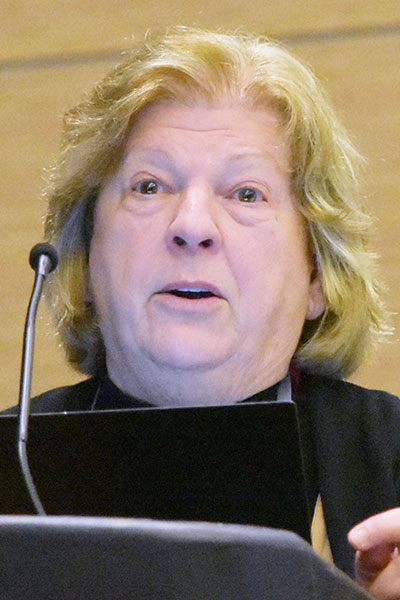In recent years, two organizations updated their guidelines for the treatment of asthma—the Expert Panel Report 4 (EPR-4) Working Group of the National Asthma Education Prevention Program (NAEPP) and the Global Initiative for Asthma (GINA). While there is significant overlap between the two, there are notable differences.
An expert panel addressed each organization’s updated recommendations during the CHEST 2024 session, Comparison of GINA and EPR-4 Asthma Guidelines: Differences and Challenges—Literature Review, on Tuesday in Boston.

The EPR-4 Asthma Management Guidelines: Focused Updates 2020 advises a step approach to care—one that can deescalate as well as escalate—explained Session Chair, Jerry A. Krishnan, MD, PhD, FCCP, Professor of Medicine and of Public Health and Associate Vice Chancellor for Population Health Sciences at the University of Illinois Chicago.
He gave an overview of the differences in EPR-4 and GINA guidelines for Steps 3 through 5 in moderate to severe asthma. Step 6, which recommends biologics, was not examined in the EPR-4 update.
“In general, you should be looking for opportunities for stepping down on therapy, and we recommend at least three months of good control,” Dr. Krishnan said, cautioning against an inclination to always step up. “Again, it depends a lot on that particular patient, but three months is probably a reasonable time frame [to ask], ‘Is it time to step down or should we continue?’”
A recommendation of single maintenance and reliever therapy (SMART) for Steps 3 and 4 was new to the 2020 guidelines and echoed by GINA’s 2023 recommended strategies. This therapy is approved in several countries, but inhaled corticosteroid (ICS)-formoterol does not have US Food and Drug Administration approval for this use.
SMART begins in Step 3 with moderate asthma. Once a patient has moved past using daily low-dose ICS and as-needed short-acting β-agonist (SABA), SMART with low-dose ICS-formoterol is recommended, Dr. Krishnan explained. At Step 4, medium-dose ICS-formoterol is the recommended treatment.
The SMART approach reduces the risk of severe exacerbations regardless of asthma phenotype, eosinophilic or non-eosinophilic, he continued.

Both the NAEPP and GINA recommend SMART for pediatric asthma patients 4 years and older, although the priority of this approach varies, said Michelle M. Cloutier, MD, Professor Emerita in Pediatrics and Medicine at the University of Connecticut. The EPR-4 updates recommend SMART beginning in Step 3, while GINA lists it as one of three therapeutic approaches. The other options are medium-dose ICS and as-needed SABA or low-dose ICS-long-acting β-agonist and as-needed SABA.
“While biologics have been tested in children, specific recommendations of exactly how to use them are really minor, and there’s a major need for that,” Dr. Cloutier said, adding that among the challenges in treating pediatric asthma is that, with few exceptions, recommendations are based on expert opinion and data extrapolation from adolescents and adults.

Shahid Sheikh, MD, FCCP, Professor of Pediatrics at The Ohio State University College of Medicine, addressed recommendations for Steps 1 and 2, which guide the treatment of mild asthma.
In children 5 to 11 years old with mild asthma, the EPR-4 recommends as-needed SABA at Step 1 and a daily low-dose ICS and as-needed SABA at Step 2, explained Dr. Sheikh. The preferred approaches outlined by GINA for this patient group are low-dose ICS whenever a SABA is taken for Step 1 and a daily low-dose ICS for Step 2.
For asthma patients 12 years or older, the EPR-4 recommends as-needed SABA at Step 1 and at Step 2, either a daily low-dose ICS and as-needed SABA or as-needed concomitant ICS and SABA. GINA has a combined treatment recommendation for Steps 1 and 2.
“If you look at the GINA guidelines, both first and second step straight away say to use as-needed ICS-formoterol as a first line of therapy, and if it doesn’t work, then go to the SMART therapy as Step 3,” Dr. Sheikh said.
Nonpharmacotherapy guidelines

Mary Cataletto, MD, FCCP, Adjunct Professor at Long Island University, discussed guidelines in nonpharmacotherapy, including allergen mitigation and immunotherapy, bronchial thermoplasty, and fractional exhaled nitric oxide (FeNO) testing.
The EPR-4 reports FeNO is best used as part of an ongoing asthma monitoring and management strategy that includes frequent assessments, Dr. Cataletto explained. FeNO testing may be helpful in determining whether an individual has asthma, but it cannot be used to diagnose asthma. Further, FeNO test results cannot be used in isolation and must account for other clinical factors and traditional measures, according to the ERP-4 recommendations.
“The FeNO should not be a routine office test,” Dr. Cataletto said. “It is something that needs subspecialty support for interpretation. And when we get to the GINA guidelines, you’ll see that they’re even stronger in terms of saying, ‘That’s a good reason for referral.’”
The most recent GINA recommendations state that FeNO can support a diagnosis of type 2 high asthma but cannot definitively rule in or rule out asthma. According to GINA, the primary role of FeNO testing is to help guide treatment decisions in moderate or severe asthma.
Join us at CHEST 2025
Save the date for the next Annual Meeting, October 19 to 22, 2025, in Chicago. CHEST 2025 will explore the latest advancements in pulmonary, critical care, and sleep medicine, with a focus on innovation and the future, just as the city itself embodies progress and reinvention.
